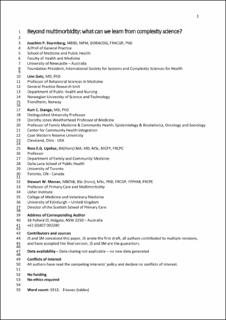Beyond multimorbidity: What can we learn from complexity science?
Peer reviewed, Journal article
Accepted version
Permanent lenke
https://hdl.handle.net/11250/3002680Utgivelsesdato
2021Metadata
Vis full innførselSamlinger
Originalversjon
Journal of Evaluation In Clinical Practice. 2021, 27 (5), 1187-1193. 10.1111/jep.13521Sammendrag
Multimorbidity - the occurrence of two or more long-term conditions in an individual - is a major global concern, placing a huge burden on healthcare systems, physicians, and patients. It challenges the current biomedical paradigm, in particular conventional evidence-based medicine's dominant focus on single-conditions. Patients' heterogeneous range of clinical presentations tend to escape characterization by traditional means of classification, and optimal management cannot be deduced from clinical practice guidelines. In this article, we argue that person-focused care based in complexity science may be a transformational lens through which to view multimorbidity, to complement the specialism focus on each particular disease. The approach offers an integrated and coherent perspective on the person's living environment, relationships, somatic, emotional and cognitive experiences and physiological function. The underlying principles include non-linearity, tipping points, emergence, importance of initial conditions, contextual factors and co-evolution, and the presence of patterned outcomes. From a clinical perspective, complexity science has important implications at the theoretical, practice and policy levels. Three essential questions emerge: (1) What matters to patients? (2) How can we integrate, personalize and prioritize care for whole people, given the constraints of their socio-ecological circumstances? (3) What needs to change at the practice and policy levels to deliver what matters to patients? These questions have no simple answers, but complexity science principles suggest a way to integrate understanding of biological, biographical and contextual factors, to guide an integrated approach to the care of people with multimorbidity.
